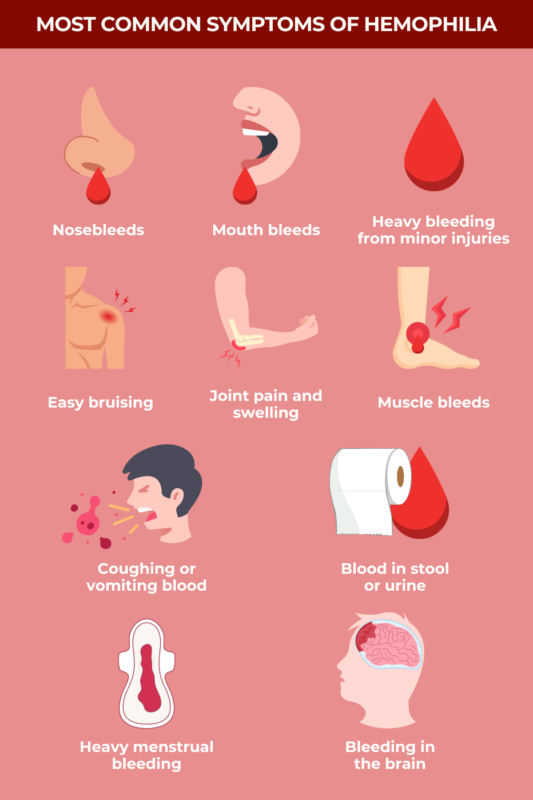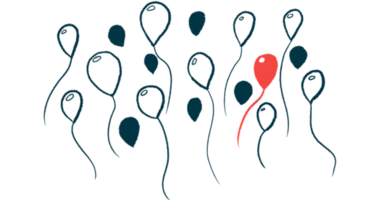Hemophilia symptoms
Hemophilia is a rare disorder in which the blood doesn’t clot properly, resulting in the disease’s hallmark symptoms of bleeds — excessive bleeding that extends over a prolonged period of time — that in turn leads to other complications. Bleeds can occur outside the body (external bleeding) or within the body (internal bleeding). In some cases, bleeds in hemophilia can lead to life-threatening blood loss, and also set the stage for other problems, including joint disease, to develop.
Common symptoms of hemophilia, in addition to bleeds and bruising of the skin, can range from unexplained nosebleeds to weakness or double vision, to blood in the urine and/or stool.
In most cases, hemophilia is caused by genetic mutations that interfere with the body’s ability to produce clotting factors, which are proteins that normally help the blood to clot. In rare cases, hemophilia also may arise due to a malfunction of the immune system that prompts it to attack certain clotting factors, causing their levels to decrease.
Hemophilia is typically divided into different types — type A, type B, and type C — based on which specific clotting factor is missing or is defective.
Excessive bleeding and bruising
Hemophilia’s main symptom is easy and excessive bleeding. Patients also commonly experience bruising, which results from bleeding occurring underneath the skin.
When a healthy person gets a cut, undergoes surgery, or bumps into something hard enough to make a bruise, the body normally recruits clotting factors to the injury site in order to slow and then stop the bleeding. Because some of these clotting factors are missing in people with hemophilia, their bleeds can prove especially difficult to control, raising the risk of even a small injury becoming a serious emergency.
Hemophilia can be generally classified as mild, moderate, or severe based on clotting factor activity:
- People with mild hemophilia have more than 5%, but less than 40%, of normal clotting factor activity.
- Individuals with moderate hemophilia have 1% to 5% of normal clotting factor activity.
- Those with severe hemophilia have less than 1% of normal clotting factor activity.
People with mild or moderate hemophilia usually only experience abnormal bleeding following an injury or surgery, and rarely experience spontaneous bleeds, which occur without any obvious cause. Given that abnormal bleeding is less obvious in milder forms of hemophilia, it’s common for these more mild cases to be not diagnosed until later in childhood or adolescence.
By comparison, individuals with severe hemophilia frequently experience spontaneous bleeds, in which bleeding occurs in the absence of any clear cause, such as after an injury. Infants with severe hemophilia usually have notable bleeding within the first few months of life, and may even experience more serious bleeding episodes while still in the womb.
Bleeding due to hemophilia can be broadly separated into two categories, depending on whether it is external or internal.
External bleeding
External bleeding refers to blood loss occurring outside the body. Signs of external bleeding in hemophilia patients generally take the form of frequent and excessive bleeds, either due to small injuries or without any obvious cause.
Forms of external bleeding that are common in hemophilia include:
- frequent and unexplained nosebleeds, called epistaxis
- heavy bleeding from a small cut or scrape, or from a wound that previously stopped bleeding
- unusual bleeding following vaccination or other procedures that puncture the skin
- unexplained bleeding from the mouth or gums, or excessive blood loss after a dental procedure, such as a tooth extraction.
Internal bleeding
Internal bleeding refers to blood loss that occurs within the body. Bruising, where bleeding occurs just underneath the skin, is a common example. People with hemophilia often bruise easily and excessively. Unexplained bruising when a child first starts walking or crawling is a common early sign of hemophilia.
A hallmark sign of hemophilia, especially in more severe cases, is bleeding into the joints, also known as hemarthrosis. This most commonly affects the knees, elbows, ankles, shoulders, wrist, and/or hips. Joint bleeds are more common in older individuals and people who are more physically active. These bleeds may cause joints to swell and become stiffer, impairing patients’ mobility and causing pain.
Muscle bleeds or hemorrhages also are relatively common, affecting 10% to 20% of hemophilia patients. These types of bleeds can be associated with significant blood loss, particularly when they occur in large muscles like those in the hips; they also can be linked with a series of complications.
Individuals with hemophilia also may experience bleeding in internal organs, such as the liver, spleen, and kidneys. This can result in symptoms like:
- abdominal pain
- swelling in the abdomen
- abnormal rigidity or tenderness in the abdomen
- blood in the stool, which may appear reddish or cause stool to be unusually dark and sticky
- blood in urine, known as hematuria
- vomiting blood, called hematemesis.
Internal bleeding in hemophilia also may occur in the chest or throat, resulting in symptoms like:
- chest pain
- shortness of breath or difficulty breathing
- coughing up blood, known as hemoptysis.
Bleeding in other parts of the body also may cause complications associated with those body parts. For example, bleeding in or near the eye can cause vision problems, while bleeding in the spine can cause back pain and unusual tingling or burning sensations known as paresthesia.
Internal bleeding anywhere in the body also is frequently marked by an abnormally fast heart beat, called tachycardia, unusually rapid breathing, known as tachypnea, and low blood pressure, or hypotension.
Bleeding in the brain also can occur in hemophilia, and generally is considered the most serious form of bleeding in the disease.
Bleeding in the brain
Bleeding in the brain, also called intracranial bleeding or intracranial hemorrhage, is a leading cause of death in hemophilia. Up to about 20% of brain bleeds in hemophilia patients may be fatal, though the risk of lethal bleeds has decreased in recent years as new treatments have become available.
Because the brain requires a lot of energy to function, it is packed with blood vessels to help supply it with nutrients and oxygen. When these vessels rupture and bleed, patients may experience symptoms like:
- prolonged headache
- frequent vomiting
- sleepiness or low energy
- double vision
- weakness
- convulsions or seizures.
Brain bleeding is more common in people with severe hemophilia than in those with milder forms of the disease. Another major risk factor for brain bleeding in hemophilia is age, with this type of bleeding being more commonly seen in children younger than 2, and in adults older than 60.
In babies with hemophilia, the risk of brain bleeding is higher for those born using assistive techniques like forceps or vacuum delivery, compared with those born via spontaneous vaginal delivery or a cesarean section. In adults, high blood pressure can increase the risk of brain bleeding. In patients of all ages, brain bleeding is less common for individuals who are on prophylactic, or preventive, treatment.

Complications
Recurrent joint bleeds can lead to a condition marked by permanent and irreversible joint damage. Called hemophilic arthropathy, this condition is characterized by pain and reduced mobility in the affected joint(s). Surgical procedures, such as joint replacement surgery, may help ease these symptoms, but usually cannot restore full functionality to the affected joint(s).
Chronic pain, especially ongoing pain affecting joints where bleeds have occurred, is common in hemophilia. In fact, as many as two-thirds of patients with severe hemophilia report experiencing daily joint pain.
Muscle bleeds also can be associated with a series of complications, depending on the specific muscle groups that are affected. When bleeding occurs in large muscles, such as those in the hips and thighs, patients may develop severe anemia and unsteady blood pressure due to extensive blood loss. Bleeding into confined muscles, such as those in the calf or forearm, may lead to compartment syndrome — a painful condition caused by an increased pressure in and around muscles.
Bleeding into certain muscles, such as those in the hips, buttocks, and forearm, also can compress specific nerves, causing pain, numbness, tingling, and other sensations.
People with hemophilia also are at an increased risk of having a low bone mineral density, which can lead to conditions like osteopenia and osteoporosis, where the bones become weaker and more prone to break or fracture.
Hemophilia often if treated with replacement therapies, which work to administer a functional version of whichever clotting factor protein patients are missing. Sometimes, the body’s immune system can mistake replacement therapies for an infectious threat. When this happens, the immune system makes antibodies called inhibitors, which bind to the delivered clotting factor and stop it from working properly. Inhibitors are more common in people with hemophilia A than in those with hemophilia B; they also are more likely to occur in Black or Hispanic individuals.
Historically, many hemophilia treatments have been made using blood collected from healthy donors. The use of these therapies in the past was associated with an increased risk of blood-borne infections, such as hepatitis and HIV, in people with hemophilia. However, with modern risk-minimizing programs in place, the chance of acquiring a blood-borne infection from hemophilia treatment in the 21st century is slim to none.
Do carriers of hemophilia have symptoms?
Hemophilia A and B are caused by mutations in genes that are found on the X chromosome, one of the two sex-determining chromosomes in humans. Females have two X chromosomes, while males have one X chromosome and one Y chromosome.
Men and boys are mainly affected by hemophilia as they have only one X chromosome. Female patients who carry one X chromosome with a mutated gene, and a second X chromosome with a healthy gene copy, are referred to as carriers, because they can pass on the mutated gene to their biological children.
Most hemophilia carriers won’t develop overt disease, but it’s common for carriers to report experiencing some unusual bleed-related symptoms, especially those who have particularly low clotting factor levels. Carrier symptoms may be underrecognized by clinicians and by patients themselves.
Heavy or irregular menstrual periods and frequent bruising are especially common among hemophilia carriers. Other symptoms that can occur in carriers include frequent nosebleeds and excessive bleeding following an injury, surgery, or childbirth.
Hemophilia News Today is strictly a news and information website about the disease. It does not provide medical advice, diagnosis or treatment. This content is not intended to be a substitute for professional medical advice, diagnosis, or treatment. Always seek the advice of your physician or other qualified health provider with any questions you may have regarding a medical condition. Never disregard professional medical advice or delay in seeking it because of something you have read on this website.
Related articles

 Fact-checked by
Fact-checked by 




